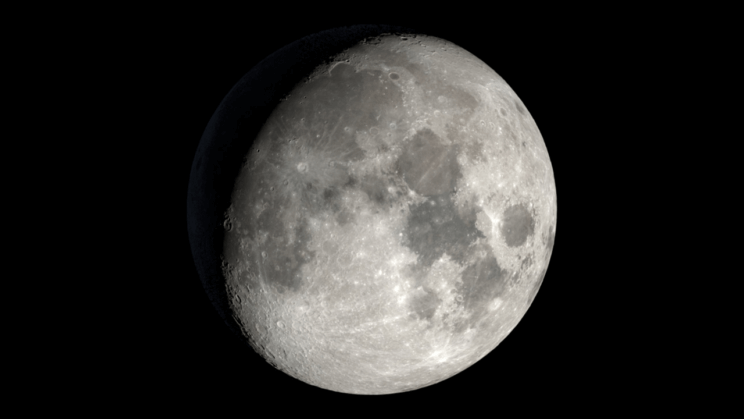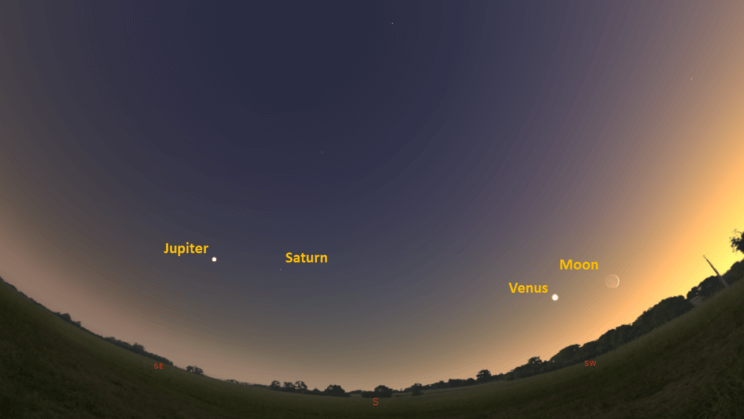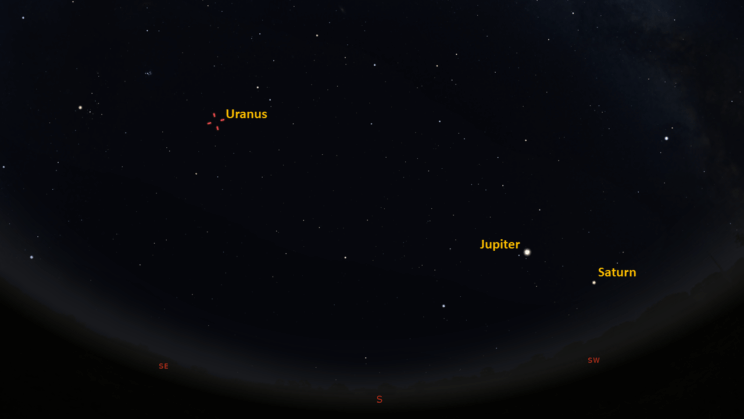This is the Saint Louis Science Center’s NIGHT SKY UPDATE for the week of Friday, October 8, 2021.
Information updated weekly or as needed.
Times given as local St. Louis time, which is Central Daylight Time (CDT). For definitions of terminology used in the night sky update, click the highlighted text. If relying on times posted in Universal Time (UT), St. Louis is -5 hours when CDT.
Public Telescope Viewings
With the changing recommendations from the CDC regarding COVID-19, conversations regarding the return of star parties at the Saint Louis Science Center have begun. We are close to bringing back our public telescope viewings, but a few details still need to be worked out. We will post future updates as we learn more about when we can bring back telescope viewings.
Observing Highlight of the Week

The that will be visible on October 16, 2021 for International Observe the Moon Night.
Image credit: NASA, SVS, Ernie Wright.
This week fall astronomy day occurs on October 9, 2021 and International Observe the Moon Night occurs on October 16, 2021. Both events aim to celebrate and bring awareness to astronomy every year.
Astronomy day was started in 1973 as a way to bring astronomy to the people. The Astronomical League states that “Astronomy Day is a grassroots movement designed to share the joy of astronomy with the general public.” Since its inception astronomy day has grown to encompass observing events hosted around the world. Each year there is a spring and fall observing event in which local astronomy clubs and scientists share their time and knowledge with those interested. The best way to get involved is to look up your local astronomy clubs. Also visit the Astronomical League’s website to find various guides and programs you can use to learn about the night sky.
International Observe the Moon Night occurs every year around September or October. This year it occurs on October 16, 2021. It is an opportunity for lunar enthusiast around the world to come together and observe and learn about the Moon. The Moon can be seen anywhere on the Earth and as such has played a major role in all cultures. Time keeping, and the discovery of our solar system were in part possible due observations of how the Moon behaves. Humanity has a long tradition of observing the Moon and we invite all to continue this. On October 16, 2021, the Moon will exhibit a waxing gibbous phase with 87% disk illumination. NASA has included several resources on their International Observe the Moon Night website that offer ways we can all celebrate this event even if you do not have binoculars or a telescope. I would start with their how to observe the Moon section.
The Sun and Moon

The Moon as seen from the International Space Station, on July 31, 2011.
Credit: NASA
Sunrise is at 7:03 a.m. on Friday, October 8 and sunset is at 6:32 p.m. providing us with roughly 11 hours and 30 minutes of daylight. Even after sunset, the light from the Sun will dimly illuminate our sky for roughly 1 hour and 30 minutes. This period is called twilight, which ends around 8:01 p.m. this week. For those with a sundial, local noon occurs around 12:48 p.m. this week.
| Day | Sunrise | Sunset |
|---|---|---|
| 2021-10-08 | 7:03 a.m. | 6:32 p.m. |
| 2021-10-09 | 7:04 a.m. | 6:31 p.m. |
| 2021-10-10 | 7:05 a.m. | 6:29 p.m. |
| 2021-10-11 | 7:06 a.m. | 6:28 p.m. |
| 2021-10-12 | 7:07 a.m. | 6:26 p.m. |
| 2021-10-13 | 7:08 a.m. | 6:25 p.m. |
| 2021-10-14 | 7:09 a.m. | 6:23 p.m. |
| 2021-10-15 | 7:10 a.m. | 6:22 p.m. |
| 2021-10-16 | 7:11 a.m. | 6:21 p.m. |
Moon
Moonrise for Friday, October 8 occurs at 9:32 a.m. and moonset will occur at 8:08 p.m. On Friday, October 8 the Moon will exhibit a waxing crescent phase with about 8% of the lunar disk illuminated. First quarter moon occurs on October 12 8 at 10:25 p.m.
International Space Station (ISS) Observing

Visible passes of ISS from St. Louis for the week of October 8 occur during evening hours. The best pass this week occurs on the evening of October 8. Use the table below for information about this and other visible passes this week.
Catch ISS from St. Louis starting Friday, October 8
| Date | Starts | Max. altitude | Ends | |||||||
|---|---|---|---|---|---|---|---|---|---|---|
| Time | Alt. | Az. | Time | Alt. | Az. | Time | Alt. | Az. | ||
| 08 Oct | -2.9 | 18:51:47 | 10 | WNW | 18:55:04 | 53 | SW | 18:58:20 | 10 | SE |
| 10 Oct | -0.8 | 18:54:35 | 10 | W | 18:56:48 | 17 | SW | 18:59:01 | 10 | S |
Magnitude (Mag): The Measure of brightness for a celestial object. The lower the value is, the brighter the object will be.
Altitude (Alt): The angle of a celestial object measured upwards from the observer’s horizon.
Azimuth (Az): The direction of a celestial object, measured clockwise from an observer’s location with north being 0°, east being 90°, south being 180° and west being 270°.
For information about ISS flyovers and other visible satellites, visit www.heavens-above.com
Detailed information regarding all unmanned exploration of our universe, missions past, present, and planned, can be found at Jet Propulsion Laboratories:
The Visible Planets

Looking South, at 6:50 p.m. October 8, 2021. Credit: Stellarium, EG

Looking south, at 12:00 am, October 9, 2021. Credit: Stellarium, EG
This week, three naked eye planets are visible. Venus can be found in the west after sunset. Jupiter and Saturn can be found in the southeast after sunset
Venus
Venus is well into another evening apparition. By 6:50 p.m., Venus will be about 14° above the western horizon. Venus will set at 8:25 p.m. As 2021 continues, Venus will continue to elongate from the Sun until October 29 when it reaches maximum eastern elongation. After this date Venus will start to head back towards the Sun as it approaches inferior conjunction on January 8, 2022.
Mars
The red planet has not been visible for several weeks now. The previous apparition of Mars has ended. But for those itching to see Mars again, you are in luck as the next apparition of Mars begins in November 2021. This week on October 8, 2021, Mars will be in conjunction with the Sun. Slowly after this date, Mars will climb out of the Sun’s glare eventually becoming visible just before sunrise. The next Mars apparition is expected to begin around November 14, 2021, when Mars will appear far enough from the Sun for safe viewing.
Jupiter
Jupiter has passed opposition and as such will be visible about 30 minutes after sunset. Look for Jupiter in the south as it starts to darken outside. Jupiter sets at 2:38 a.m. tomorrow morning and will set about 30 minutes earlier each week. Jupiter reaches superior conjunction on March 5, 2022. This means we can count on seeing Jupiter in the south for the rest of this year and well into 2022.
Saturn
Saturn is past opposition which means it will be visible about 30 minutes after sunset. Right now, it can be found in the south after sunset, but as we continue through the year, Saturn will set about 30 minutes earlier each night. Saturn sets at 1:20 a.m. Saturn will reach superior conjunction on February 4, 2022.
Uranus
Uranus will reach opposition on November 5, 2021, at 0 hrs. UT. For us in St. Louis, that translates to 19:00 or 7:00 p.m. CDT. When near opposition, Uranus can be seen naked eye under dark skies. In St. Louis you will need binoculars to spot this ice giant. Uranus rises at 7:39 p.m. and will be easily found by 9:30 pm in the east in the constellation Aries.
James S. McDonnell Planetarium
Night Sky Update: October 8 – October 16, 2021






